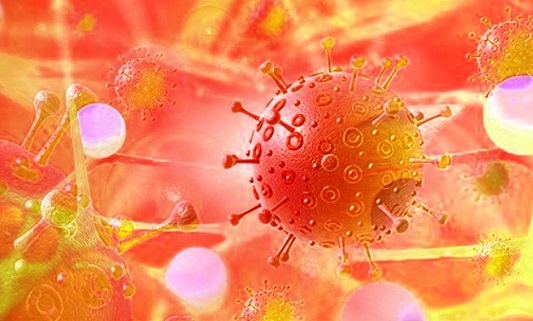Nikhil Prasad Fact checked by:Thailand Medical News Team Feb 16, 2025 1 month, 3 weeks, 5 days, 1 hour, 46 minutes ago
Medical News: Scientists Unveil a New Natural Defense Against SARS-CoV-2
A team of researchers from the Chinese Academy of Medical Sciences and Peking Union Medical College, along with scientists from Peking University and Suzhou Institute of Systems Medicine, have discovered a promising new defense mechanism against SARS-CoV-2, the virus responsible for COVID-19. Their study highlights the role of phospholipid scramblase 1 (PLSCR1), an interferon-stimulated gene (ISG), in restricting viral entry into human cells.
 PLSCR1 Suppresses SARS-CoV-2 Infection by Reducing ACE2 on Cell Surface
PLSCR1 Suppresses SARS-CoV-2 Infection by Reducing ACE2 on Cell Surface
Since the onset of the COVID-19 pandemic, researchers have been trying to understand how the human immune system naturally fights against the virus. Many studies have focused on interferon-stimulated genes that help inhibit viral infections. This
Medical News report explores the latest breakthrough in this field, showing how PLSCR1 plays a crucial role in lowering the ability of SARS-CoV-2 to enter human cells by reducing the availability of its main receptor, ACE2, on the cell surface.
The Role of PLSCR1 in Virus Defense
PLSCR1 is a protein known to be induced by interferons, which are the body's first line of defense against viral infections. The research team conducted an extensive screening of 109 different ISG-knockout cell lines to identify genes that influence SARS-CoV-2 infection. The findings revealed that cells lacking PLSCR1 were highly susceptible to SARS-CoV-2, while those with overexpressed PLSCR1 showed significant resistance to viral entry.
The study confirmed that PLSCR1 exerts its antiviral effects by specifically reducing the presence of ACE2 on the cell surface. ACE2 is the key receptor used by SARS-CoV-2 to attach to human cells and initiate infection. However, PLSCR1 does not affect the overall quantity of ACE2 in the cell but rather alters its localization, preventing it from appearing on the cell membrane where the virus can access it. This mechanism acts as a strong natural barrier against infection.
How PLSCR1 Inhibits SARS-CoV-2 Entry
The researchers employed several experimental approaches, including genetic knockout models, viral infection assays, and pseudovirus infection studies, to validate their findings. When they knocked out the PLSCR1 gene, they observed a significant increase in viral replication and infectivity. Conversely, when they overexpressed PLSCR1 in human lung and kidney cells, they noted a dramatic decrease in SARS-CoV-2 infection.
To further understand how PLSCR1 regulates ACE2, they conducted immunofluorescence assays and plasma membrane isolation experiments. These experiments revealed that in the presence of PLSCR1, ACE2 is retained inside the cell rather than being transported to the cell membrane. This means that even though ACE2 is still produced, the virus cannot effectively bind to it, making it harder for the infection to spread.
Broad Protection Against Multiple Variants
One of the most significant findings of this s
tudy is that PLSCR1 is effective against multiple SARS-CoV-2 variants, including the Alpha, Beta, Gamma, Delta, and Omicron strains. The researchers tested pseudoviruses carrying spike proteins from these variants and found that PLSCR1 consistently inhibited their ability to enter human cells. Although its inhibitory effect was slightly weaker against the Omicron variant, PLSCR1 still demonstrated a strong defense against infection.
Additionally, the study explored whether PLSCR1 could suppress cell-to-cell fusion mediated by the SARS-CoV-2 spike protein. This process, known as syncytia formation, allows infected cells to merge with uninfected cells, helping the virus spread more efficiently. The findings showed that PLSCR1 significantly reduced this form of viral transmission, further solidifying its role as a powerful antiviral factor.
The H262Y Mutation and Its Effect on PLSCR1
The researchers also investigated a naturally occurring mutation in the PLSCR1 gene, known as H262Y, which has been linked to an increased risk of severe COVID-19. Their experiments revealed that this mutation weakens PLSCR1's ability to prevent SARS-CoV-2 infection. Cells expressing the mutated form of PLSCR1 did not exhibit the same reduction in ACE2 surface levels, allowing the virus to enter more easily. This discovery suggests that genetic differences in PLSCR1 may partially explain why some individuals are more vulnerable to severe COVID-19 than others.
Potential for Future Therapeutic Strategies
The discovery of PLSCR1’s antiviral function opens up new possibilities for developing treatments against COVID-19. The researchers suggest that therapies aimed at increasing PLSCR1 activity could serve as a novel approach to preventing SARS-CoV-2 infections. Since PLSCR1 does not completely eliminate ACE2 but only regulates its localization, targeting this mechanism could provide a way to reduce viral infection without interfering with ACE2’s essential functions in other physiological processes.
Future studies will focus on understanding how PLSCR1 interacts with cellular pathways to regulate ACE2 and whether pharmacological agents can be used to enhance its antiviral effects. By leveraging this newfound knowledge, scientists hope to develop innovative therapies that could offer broad protection against both current and future coronavirus threats.
Conclusion
This study represents a major step forward in understanding the natural antiviral mechanisms of the human body. By identifying PLSCR1 as a key factor in reducing SARS-CoV-2 entry into cells, researchers have unveiled a potential target for new therapeutic strategies. The ability of PLSCR1 to inhibit multiple variants of SARS-CoV-2 highlights its importance in the ongoing fight against COVID-19.
As scientists continue to explore ways to harness the power of interferon-stimulated genes for antiviral defense, the role of PLSCR1 could become increasingly significant in developing future treatments. If researchers can find ways to enhance PLSCR1 function in patients, it could serve as a valuable tool in reducing the impact of SARS-CoV-2 and other emerging viral threats.
The study findings were published in the peer-reviewed journal: Journal of Virology.
https://journals.asm.org/doi/10.1128/jvi.02085-24
For the latest COVID-19 News, keep on logging to Thailand
Medical News.
Read Also:
https://www.thailandmedical.news/news/new-insights-reveal-human-body-s-defense-against-covid-19-virus
https://www.thailandmedical.news/news/sars-cov-2-is-mutating-to-replicate-better-at-lower-temperatures-found-in-the-human-upper-respiratory-tract
https://www.thailandmedical.news/news/french-study-finds-that-sars-cov-2-preferentially-infects-intestinal-cells-causing-barrier-damage-and-potential-systemic-spread
https://www.thailandmedical.news/articles/coronavirus
https://www.thailandmedical.news/pages/thailand_doctors_listings
Follow us on:
https://x.com/ThailandMedicaX
https://www.facebook.com/ThailandMedicalNews
https://bsky.app/profile/thailandmedical.bsky.social
https://gettr.com/user/thailandmedicalnews
https://www.tribel.com/thailandmedical/wall
and 33 other social media platforms
